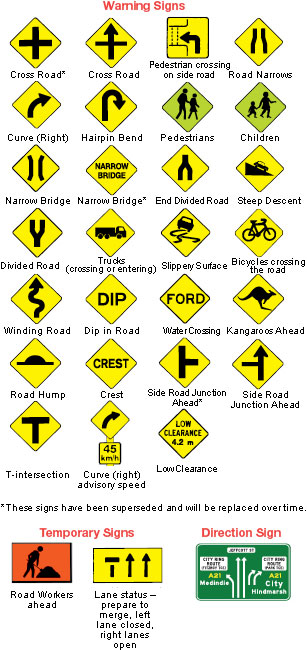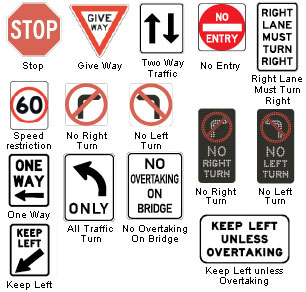Discover the basics of safe driving in Australia with our easy-to-follow Australian Road Rules guide. Whether you are a new or experienced driver, this resource takes you through important rules, gives practical tips, and encourages a safe driving culture. Join us as we share the essentials for a secure and responsible driving experience on Australia’s diverse roads.
Key Driving Regulations in Australia
Australia’s vast and diverse road network is governed by crucial driving regulations, essential for fostering a culture of safe and responsible travel. This comprehensive breakdown delves into three pivotal aspects that shape the driving experience across the continent.
Speed Limits and Enforcement
Understanding Speed Limits:
Navigating Australian roads involves comprehending the nuanced speed limits tailored for various settings. In residential areas, speeds typically range from 25 to 50 km (about 31.07 mi)/hour, while urban roads vary between 40 to 70 km (about 43.5 mi)/hour. Rural roads often have limits of 80 to 100 km (about 62.14 mi)/hour, and highways can span from 90 to 110 km (about 68.35 mi)/hour.
Enforcement Measures:
To uphold these speed limits, enforcement mechanisms include radar checks, speed cameras, and penalties for violations. Adhering to these limits ensures not only personal safety but contributes to an overall safer road environment.
Traffic Signals and Road Signs Decoded
Driving on the roads is not only about knowing how to operate a car; it also means having a full understanding of traffic lights and road signs. In our guide, we explain the important signals and signs that direct and control traffic for a more secure and knowledgeable drive.
It’s important to know these, especially when you are renting a car in Australia.
Navigating the Symbolic Language of the Road:
Roads communicate through signals and signs, forming a symbolic language crucial for drivers. Traffic lights, with their red, yellow, and green indicators, dictate actions. Stop signs necessitate a full stop, while yield signs require giving way to other traffic. Speed limit signs guide drivers on permissible speeds, and warning signs alert them to potential hazards on the road.
Regulatory signs

Stop:
When encountering a Stop sign, it is mandatory to bring your vehicle to a complete stop at the designated stop line. If there is no stop line, you should halt as close as possible to the intersection before proceeding. The requirement to yield at a Stop sign is detailed in Examples 18 and 20.
Give Way:
When confronted with a Give Way sign, reduce your speed and, if necessary, come to a complete stop to yield the right of way. The protocol for giving way at a Give Way sign is outlined in Example 19.
Speed Limit:
Speed limit signs are characterised by a distinctive red circle with a black number denoting the speed limit in kilometres per hour. Various speed limits and their applicable areas are explained. See here for warning signs, temporary signs, and direction signs.
No Right/Left Turn:
Normal or illuminated signs may indicate the prohibition of either right or left turns. This restriction applies when the sign is illuminated, during the specified time on the sign, or at all times if no specific time is indicated.
Warning Signs:
These signs serve as alerts that you are approaching an unexpected, hazardous, or unusual feature on the road. Adhering to these signs will enhance safety and courtesy on the roads. Some warning signs on curves or bends may have safe speed advice signs beneath them, indicating the maximum safe speed for negotiating the bend under optimal driving conditions. Hazard marker signs also indicate risks on the road.
Direction Signs:
Direction signs provide information on distances and/or directions to towns and major roads. They also guide you to services such as emergency telephones, caravan parks, off-street parking, and information bays.
Temporary Signs:
Temporary signs are erected to caution drivers about roadworks or other temporary hazards, such as loose stones, detours, and closed lanes.
Enhancing Driver Comprehension:
Decoding these symbols enhances driver comprehension, empowering individuals to navigate roads with confidence. Understanding the meaning behind each signal and sign is integral to fostering a secure and efficient driving experience.
Navigating Australian Roundabouts
Circular Junctions with Specific Rules:
Australian roundabouts, distinctive features of intersections, demand specific driving skills.
Rules for Safe Roundabout Driving:
- Give Way Principle:
- Yield to vehicles already in the roundabout.
- Choosing the Correct Lane:
- Stay in the appropriate lane for your exit.
- Use of Indicators:
- Signal your intentions to other drivers.
Common Mistakes to Avoid:
- Failure to Yield:
- Neglecting to give way to vehicles on the right.
- Incorrect Lane Usage:
- Inappropriately changing lanes within the roundabout.
- Missing Exit:
- Failing to exit at the chosen junction.
By understanding and adhering to these regulations, drivers contribute to creating a safer, more efficient, and harmonious road environment in Australia. Each regulation plays a vital role in fostering a culture of responsible and secure driving across the continent’s diverse landscapes.
Parking Etiquette and Regulations
Parking, an essential element of road use, demands a nuanced understanding of etiquettes and regulations, particularly tailored for Australian citizens. This section delves into key aspects, ensuring a thorough comprehension for locals.
On-Street Parking Guidelines
Navigating on-street parking is crucial for maintaining fairness and accessibility within local communities. Dive into specific guidelines:
- Respect Time Limits: Adhering to designated time limits ensures efficient turnover and avoids overstaying.
- Adhere to Permit Requirements: Comply with permit restrictions, promoting the intended use of designated areas.
- Park within Marked Spaces: Ensuring vehicles are parked within marked spaces prevents traffic disruptions and promotes smooth flow.
Parking Signage
Deciphering parking signs is akin to understanding a symbolic language. Delve into the details:
- Time Restrictions: Signs communicate specific periods for parking, demanding strict adherence.
- Permit Zones: Recognition of various permit zones ensures compliance and averts penalties.
- Designated Spaces: Understanding specific spaces, such as loading zones or disabled parking, enhances precision.
Defensive Driving Techniques
While parking may seem routine, embracing defensive driving techniques is crucial for the safety of both drivers and pedestrians. Explore these strategies:
- Vigilance: Stay alert to pedestrians and vehicles in the parking area, mitigating collision risks.
- Blind Spot Awareness: Consciousness of blind spots when maneuvering in and out of parking spaces minimises potential accidents.
- Mirror Use: Regularly check mirrors before maneuvering, enhancing awareness of the surroundings.
Importance of Defensive Driving
The ethos of defensive driving extends beyond parking scenarios, profoundly impacting overall road safety. Explore its broader significance:
- Risk Reduction: Defensive driving actively reduces the risk of accidents and collisions, promoting safety on Australian roads.
- Overall, Road Safety: A defensive driving mindset contributes to an environment where all road users can navigate with confidence.
- Proactive Measures: Encourages proactive measures to anticipate and avert potential hazards, fostering a culture of responsibility.
Tips for Handling Challenging Driving Situations
Driving in Australia poses diverse challenges and handling them requires a strategic approach. Explore practical tips:
- Safe Following Distance: In heavy traffic, maintaining a safe following distance minimises the risk of rear-end collisions.
- Adaptive Speed: Adjust driving speed according to weather conditions, promoting safety in adverse weather.
- Focus and Avoid Distractions: Staying focused on the road and avoiding distractions enhances overall driving safety.
Driver’s Licence Requirements for Australian Citizens
The acquisition and maintenance of a driver’s licence involve a phased process, specifically tailored for Australian citizens. Navigate through the steps:
Obtaining a Driver’s Licence
- Learner’s Permit: Initiate the journey by completing the written test and practising driving under a learner’s permit.
- Provisional Licence: Progress by passing the practical driving test and fulfilling required driving hours.
- Full Licence: Attain a full licence after completing the provisional period and passing the final driving test.
Renewing a Driver’s Licence
- Check Renewal Eligibility: Ensure your licence is eligible for renewal.
- Renew Online or In-Person: Follow the renewal process through the relevant authority for a seamless continuation.
Licence Points System in Australia
Australia’s licence points system serves as a regulatory mechanism, emphasising responsible driving behaviour for its citizens. Delve into the specifics:
- Point Allocation: Points are assigned for various traffic offences, underlining the importance of adherence to traffic laws.
- Consequences of Accumulation: Accumulating excessive points can result in licence suspension, highlighting the significance of responsible driving.
Pedestrian Safety Laws in Australia
Understanding pedestrian safety laws is vital for fostering a secure road environment. Delve into specific aspects of crosswalk etiquette, penalties for violating pedestrian rights, alcohol limits, and DUI laws.
Crosswalk Etiquette
Navigating crosswalks requires a harmonious interaction between pedestrians and drivers. Explore essential crosswalk etiquette:
- Pedestrian Right-of-Way: Respect pedestrian right-of-way, allowing them to cross safely.
- Stopping at Crosswalks: Drivers should come to a complete stop when pedestrians are in the crosswalk.
- Lookout for Signals: Obey traffic signals, especially pedestrian crossing signals.
Penalties for Violating Pedestrian Rights
Ensuring pedestrian safety involves enforcing penalties for violations. Understand the consequences:
- Monetary Fines: Drivers may face fines for failing to yield to pedestrians.
- Licence Points: Accumulating points on the driver’s licence for repeated offences.
- Educational Programs: Completion of pedestrian safety education programs may be mandated.
Alcohol Limits and DUI Laws
Maintaining sobriety while driving is paramount for safety. Delve into the alcohol limits and consequences for driving under the influence (DUI):
Blood Alcohol Concentration (BAC) Limits
- Legal Limit: Understand the legal limit for BAC while driving.
- Variable Limits: Different limits may apply for certain driver categories.
Consequences of Driving Under the Influence
- Licence Suspension: Immediate suspension of the driver’s licence.
- Legal Penalties: Fines, community service, or imprisonment, depending on the severity.
- Ignition Interlock Devices: Installation of devices preventing the vehicle from starting if alcohol is detected.
Road Etiquette in Australia
Promoting courteous driving practices enhances overall road safety. Explore guidelines for merging and yielding:
Courteous Driving Practices
- Signal Usage: Use signals to indicate turns or lane changes, allowing other drivers to anticipate your actions.
- Maintain Safe Distances: Keep a safe following distance to avoid abrupt stops.
- Observe Speed Limits: Adhering to speed limits ensures a safe and controlled driving environment.
Merging and Yielding Guidelines
Efficient merging and yielding contribute to smooth traffic flow. Understand the guidelines:
- Merge Early: Plan and merge early when lanes are merging.
- Yield to Pedestrians: Prioritise pedestrians when merging or yielding.
- Alternate Merging: In situations where two lanes merge into one, practise alternate merging.
Traffic Fines and Penalties in Australia
Navigating the road comes with a set of rules, and understanding traffic fines and penalties is crucial for responsible driving. Explore common traffic violations and penalties, along with the dispute resolution process.
Common Traffic Violations and Penalties
A comprehensive understanding of common traffic violations helps drivers stay informed and avoid potential penalties. Delve into the specifics:
- Speeding Offenses: Exceeding posted speed limits can result in fines and, in severe cases, licence demerit points.
- Running Red Lights: Disregarding traffic signals may lead to substantial fines and potential licence penalties.
- Illegal Parking: Parking in restricted zones or obstructing traffic can result in fines and towing of the vehicle.
- Mobile Phone Use While Driving: Using a mobile phone without hands-free devices can attract fines and demerit points.
- Seatbelt Violations: Failure to wear seatbelts, or ensuring passengers do the same, can result in fines.
Dispute Resolution Process
In case of disagreements with issued fines, understanding the dispute resolution process is crucial. Navigate through the steps:
- Request Review: Submit a formal request for a review of the issued fine within the stipulated timeframe.
- Provide Evidence: Present relevant evidence supporting your case, such as witness statements or photographic evidence.
- Review Outcome: Authorities will reassess the fine based on the provided evidence and inform you of the outcome.
- Appeal Process: If unsatisfied with the review outcome, you may have the option to escalate the matter through an appeals process.
Navigating Australian Roads with Alpha Car Hire
Discovering the beauty of Australia requires not only an understanding of road rules but also reliable transportation. This brief guide explores essential Australian road rules, emphasising safe driving practices. Covering pedestrian safety laws, alcohol limits, and traffic fines, it equips readers with a thorough understanding of road regulations.
Explore crosswalk etiquette, penalties for violations, and the dispute resolution process for insights into responsible driving. Enhance your journey with Alpha Car Hire, offering an extensive fleet and convenient rental options for comfortable and safe exploration of Australia. Whether deciphering traffic fines or securing reliable transportation, this concise guide is your resource for a safe road experience Down Under.
[/vc_column_text][/vc_column][/vc_row]





